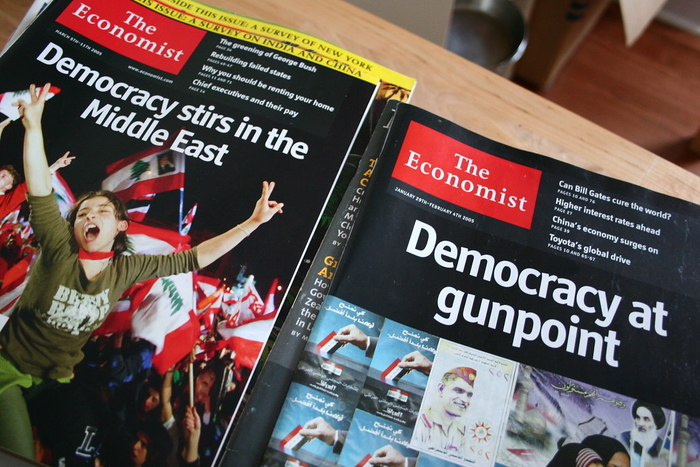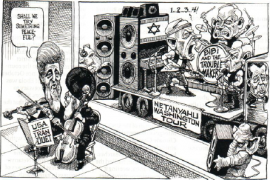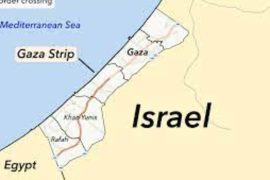We recently came across an Economist article published during the recent conflict between Hamas and Israel that gets the Israeli view of their conflict with the Palestinians completely wrong.
The article (“The Israel-Palestine conflict has claimed 14,000 lives since 1987″, May 18th) begins by providing context on the cause of the May war, before pivoting to statistics by the radical anti-Israel NGO B’Tselem claiming that between December 1987 and April 2021 “the conflict claimed nearly 14,000 lives – 87% of whom were Palestinian”.
The Economist then adds its own context:
The bloodshed has come in different phases. The first Palestinian intifada, or “shaking off” of 1987 was a shock to Israel at the time and was the backdrop for the Oslo peace accords of 1994. They pointed the way to a two-state solution: the creation of a Palestinian state in territories occupied by Israel in 1967.
In fact, the Oslo Peace Accords did not call for a two-state solution.
The article continues:
But instead of peace came more violence. Extremists on both sides sought to destroy the compromise; Hamas and another radical faction, Islamic Jihad, in particular, embarked on a campaign of suicide-bombings; Israel responded with harsher security measures, including ever greater restrictions on the Gaza Strip.
The Economist’s “extremists on both sides” framing of the years following Oslo is extraordinarily misleading. Though, in 1994, Jewish extremist Baruch Goldstein massacred 29 Muslim worshipers in Hebron, every other terror attack in the years following Oslo was committed by a Palestinian perpetrator.
The article continues:
The failure of the Camp David talks in 2000 sparked the second, and far more violent intifada, which shifted from stone-throwing to the use of weapons, not least by the Palestinian Authority established under the Oslo accords, and more suicide-bombings
This is revisionist history.
After Arafat’s refusal to agree to the US-brokered Israeli peace offer at Camp David that would have created a Palestinian state, a rejection that President Clinton called “a mistake of historic proportions”, he launched an intifada – using Ariel Sharon’s peaceful visit to the Temple Mount as a pretext – to turn attention away from his widely criticised rejection.
Then, the Economist buries the lede:
It prompted Israel to build a security barrier in the West Bank and to withdraw from Gaza in 2005. And since Hamas seized power in the enclave, there have been repeated rounds of fighting—the deadliest of which erupted in 2014.
A more accurate take-away – which would contradict the desired narrative – is that, despite of Israel’s unilateral withdrawal from Gaza, Palestinians in Gaza handed Hamas – the group committed to Israel’s annihilation – a victory in parliamentary elections, ushering in, not more peace as most commentators predicted following the disengagement, but year after year of terror and war.
The Economist article ends thusly:
…in the 15 years between the second intifada, which began in September 2000, and the end of the second Gaza war in August 2014, 800 people died each year, on average. Since then, victims have numbered 175 a year. In the same period, Israeli deaths fell from 85 a year to 14.
Israel’s military might, its erection of security barriers and its deployment of anti-missile defences mean that, for most Israelis, most of the time, the conflict is out of sight and out of mind. Relations with Palestinians barely featured as an issue in the four elections Israel has held in the past two years. The international outcry over the plight of Palestinians is unlikely to change this mindset. The latest fighting may show how the unjust treatment of the Palestinians stores up trouble. But even now, the endless occupation seems tolerable to many Israelis who have lost faith in peace.
First, it’s misleading to claim that Israelis have “lost faith in peace”. It’s more accurate to say that, whilst a plurality of Israelis (including the alternate Prime Minister) still support two states, most Israelis, due to Palestinian peace rejections, the rise of Hamas and the barbarism of the 2nd Intifada, have lost faith in the Palestinian leadership’s desire to truly live in peace with the Jewish state.
But, there’s one more major error in the Economist’s analysis.
Their claim that “Israel’s military might…security barriers and its deployment of anti-missile defences mean that, for most Israelis…the conflict is out of sight and out of mind” would suggest that the relative dearth of terror casualties makes Israelis less disposed to take the pursuit of peace, and the Palestinian issue more broadly, seriously. If you follow this logic, it would seem that a major increase in Israeli fatalities would be a net positive, making the country more amenable to further territorial withdrawal and peace.
However, something closer to the opposite is true.
If Hamas stopped launching terror attacks on Israeli cities from Gaza, and the PA ceased their institutionalized terror culture in the West Bank and committed to co-existence projects and negotiations with Jerusalem without pre-conditions, the likely result would be an Israeli electorate more open to making relations with the Palestinians a priority.
But, of course, to acknowledge such a dynamic – the necessary relationship between Palestinian behavior and Israeli-Palestinian peace – would be to impute agency to Palestinians, something foreign reporters covering the region are loath to do.






B’Tselem is a criminal outfit, whose operatives are responsible for getting Palestinians who sell land to Jews tortured and murdered by the PA gestapo.
http://www.israelnationalnews.com/News/News.aspx/206141#.V3fApLgrLtQ
B’Tselem defends executing Palestinians who sell land to Jews.